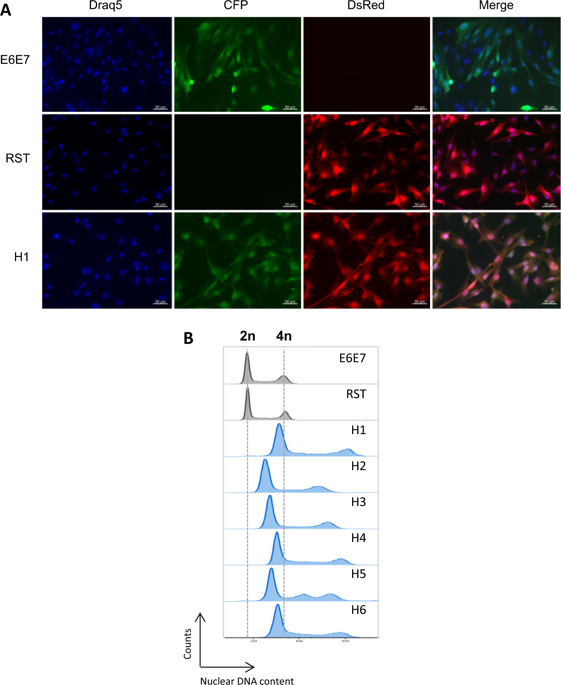Our official English website, www.x-mol.net, welcomes your
feedback! (Note: you will need to create a separate account there.)
Genome remodeling upon mesenchymal tumor cell fusion contributes to tumor progression and metastatic spread.
Oncogene ( IF 6.9 ) Pub Date : 2020-04-02 , DOI: 10.1038/s41388-020-1276-6 Lydia Lartigue 1, 2 , Candice Merle 3, 4 , Pauline Lagarde 1, 2, 5 , Lucile Delespaul 3 , Tom Lesluyes 3 , Sophie Le Guellec 3, 6 , Gaelle Pérot 3, 6 , Laura Leroy 3, 6 , Jean-Michel Coindre 1, 2, 5 , Frédéric Chibon 1, 3, 5, 6
Oncogene ( IF 6.9 ) Pub Date : 2020-04-02 , DOI: 10.1038/s41388-020-1276-6 Lydia Lartigue 1, 2 , Candice Merle 3, 4 , Pauline Lagarde 1, 2, 5 , Lucile Delespaul 3 , Tom Lesluyes 3 , Sophie Le Guellec 3, 6 , Gaelle Pérot 3, 6 , Laura Leroy 3, 6 , Jean-Michel Coindre 1, 2, 5 , Frédéric Chibon 1, 3, 5, 6
Affiliation

|
Cell fusion in tumor progression mostly refers to the merging of a cancer cell with a cell that has migration and immune escape capabilities such as macrophages. Here we show that spontaneous hybrids made from the fusion of transformed mesenchymal cells with partners from the same lineage undergo nonrecurrent large-scale genomic rearrangements, leading to the creation of highly aneuploid cells with novel phenotypic traits, including metastatic spreading capabilities. Moreover, in contrast to their parents, hybrids were the only cells able to recapitulate in vivo all features of human pleomorphic sarcomas, a rare and genetically complex mesenchymal tumor. Hybrid tumors not only displayed specific mesenchymal markers, but also combined a complex genetic profile with a highly metastatic behavior, like their human counterparts. Finally, we provide evidence that patient-derived pleomorphic sarcoma cells are inclined to spontaneous cell fusion. The resulting hybrids also gain in aggressiveness, exhibiting superior growth capacity in mouse models. Altogether, these results indicate that cell fusion has the potential to promote cancer progression by increasing growth and/or metastatic capacities, regardless of the nature of the companion cell. Moreover, such events likely occur upon sarcoma development, paving the way for better understanding of the biology, and aggressiveness of these tumors.
中文翻译:

间充质肿瘤细胞融合后的基因组重塑有助于肿瘤进展和转移扩散。
肿瘤进展中的细胞融合主要是指癌细胞与具有迁移和免疫逃逸功能的细胞(例如巨噬细胞)合并。在这里,我们显示了由转化的间充质细胞与相同谱系的伴侣融合而成的自发杂种,会经历非周期性的大规模基因组重排,从而导致具有新表型特征(包括转移扩散能力)的高度非整倍性细胞的产生。而且,与其父母相比,杂种是唯一能够在体内概括人多形性肉瘤(一种罕见且遗传复杂的间充质肿瘤)所有特征的细胞。杂种肿瘤不仅表现出特定的间充质标志物,而且还像人类同伴一样,将复杂的遗传特征与高度转移的行为结合在一起。最后,我们提供的证据表明,患者来源的多形性肉瘤细胞倾向于自发细胞融合。所得的杂种也具有侵略性,在小鼠模型中表现出出众的生长能力。总而言之,这些结果表明细胞融合具有通过增加生长和/或转移能力来促进癌症进展的潜力,而与伴侣细胞的性质无关。此外,此类事件可能在肉瘤发生时发生,从而为更好地了解生物学和这些肿瘤的侵袭性铺平了道路。这些结果表明,无论伴随细胞的性质如何,细胞融合都有可能通过增加生长和/或转移能力来促进癌症进展。此外,此类事件可能在肉瘤发生时发生,从而为更好地了解生物学和这些肿瘤的侵袭性铺平了道路。这些结果表明,无论伴随细胞的性质如何,细胞融合都有可能通过增加生长和/或转移能力来促进癌症进展。此外,此类事件可能在肉瘤发生时发生,从而为更好地了解生物学和这些肿瘤的侵袭性铺平了道路。
更新日期:2020-04-02
中文翻译:

间充质肿瘤细胞融合后的基因组重塑有助于肿瘤进展和转移扩散。
肿瘤进展中的细胞融合主要是指癌细胞与具有迁移和免疫逃逸功能的细胞(例如巨噬细胞)合并。在这里,我们显示了由转化的间充质细胞与相同谱系的伴侣融合而成的自发杂种,会经历非周期性的大规模基因组重排,从而导致具有新表型特征(包括转移扩散能力)的高度非整倍性细胞的产生。而且,与其父母相比,杂种是唯一能够在体内概括人多形性肉瘤(一种罕见且遗传复杂的间充质肿瘤)所有特征的细胞。杂种肿瘤不仅表现出特定的间充质标志物,而且还像人类同伴一样,将复杂的遗传特征与高度转移的行为结合在一起。最后,我们提供的证据表明,患者来源的多形性肉瘤细胞倾向于自发细胞融合。所得的杂种也具有侵略性,在小鼠模型中表现出出众的生长能力。总而言之,这些结果表明细胞融合具有通过增加生长和/或转移能力来促进癌症进展的潜力,而与伴侣细胞的性质无关。此外,此类事件可能在肉瘤发生时发生,从而为更好地了解生物学和这些肿瘤的侵袭性铺平了道路。这些结果表明,无论伴随细胞的性质如何,细胞融合都有可能通过增加生长和/或转移能力来促进癌症进展。此外,此类事件可能在肉瘤发生时发生,从而为更好地了解生物学和这些肿瘤的侵袭性铺平了道路。这些结果表明,无论伴随细胞的性质如何,细胞融合都有可能通过增加生长和/或转移能力来促进癌症进展。此外,此类事件可能在肉瘤发生时发生,从而为更好地了解生物学和这些肿瘤的侵袭性铺平了道路。











































 京公网安备 11010802027423号
京公网安备 11010802027423号